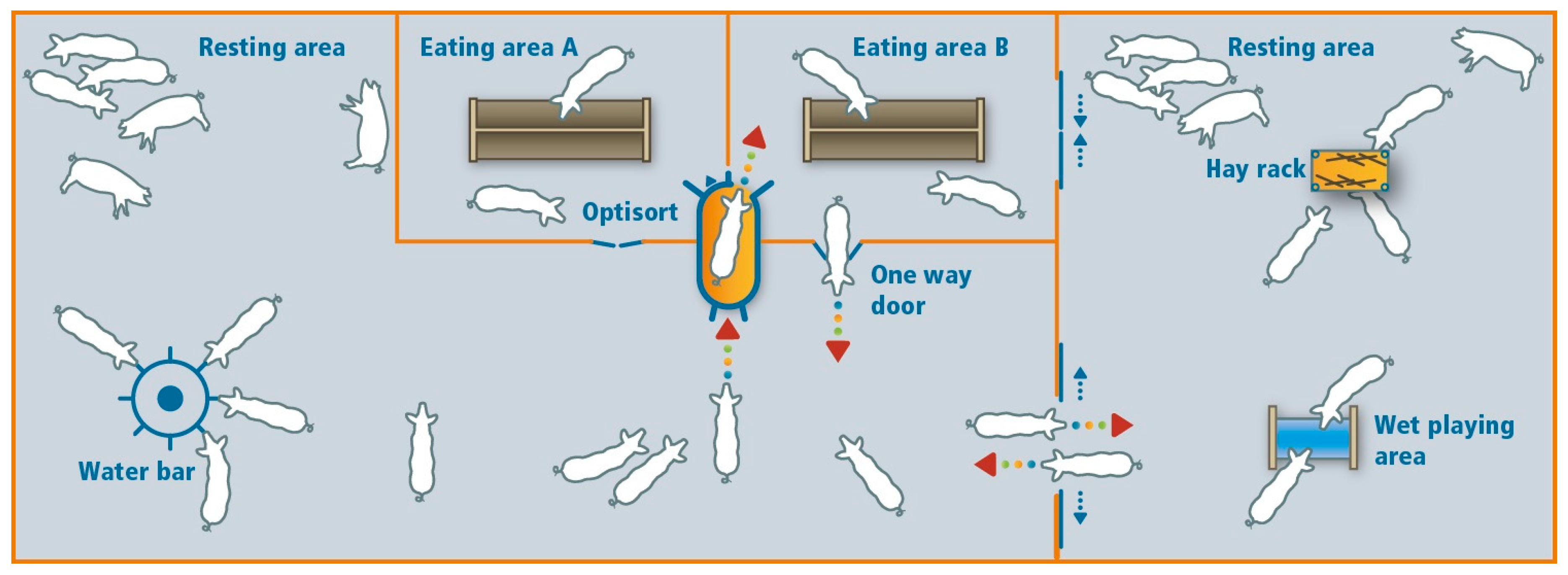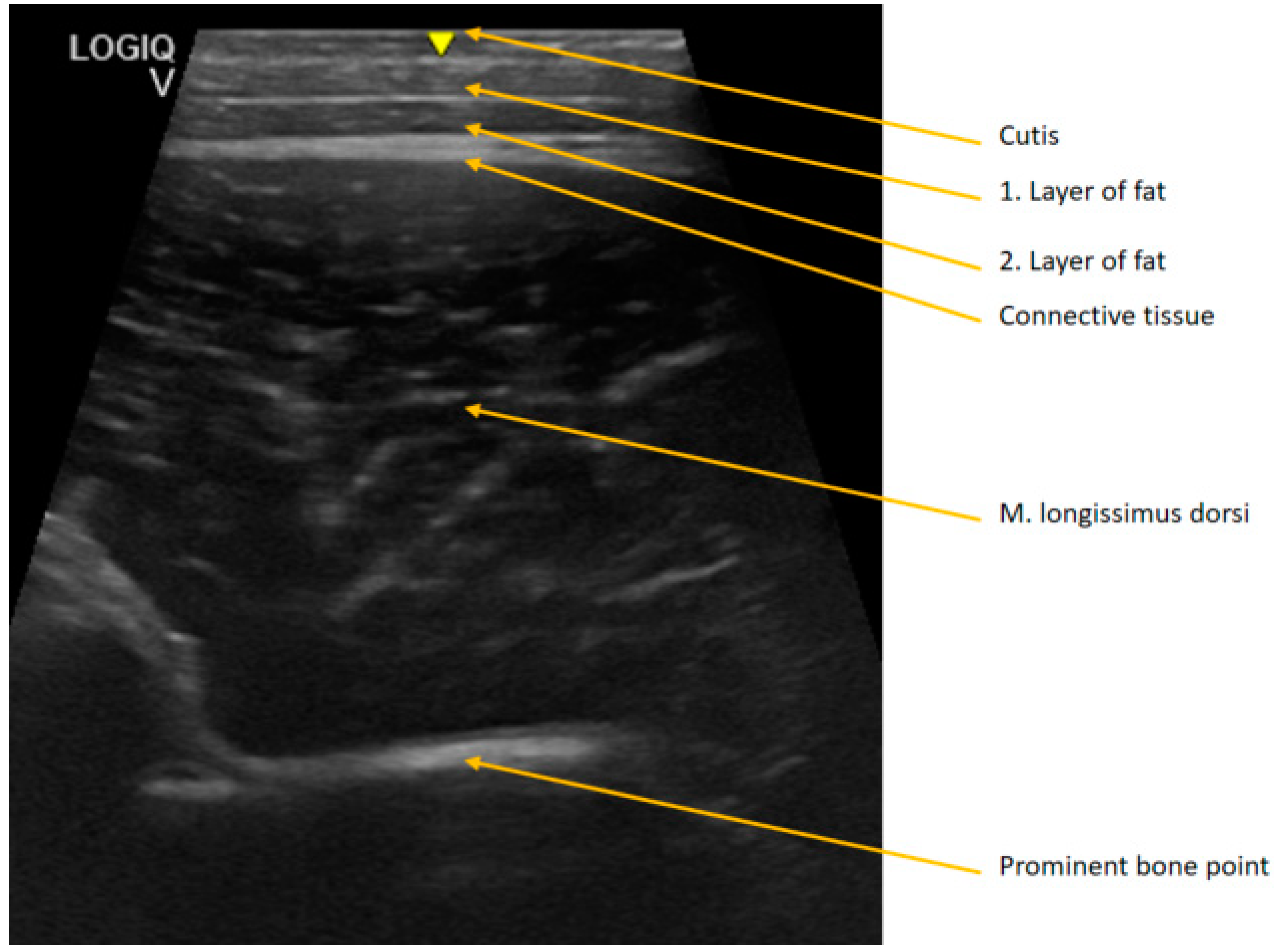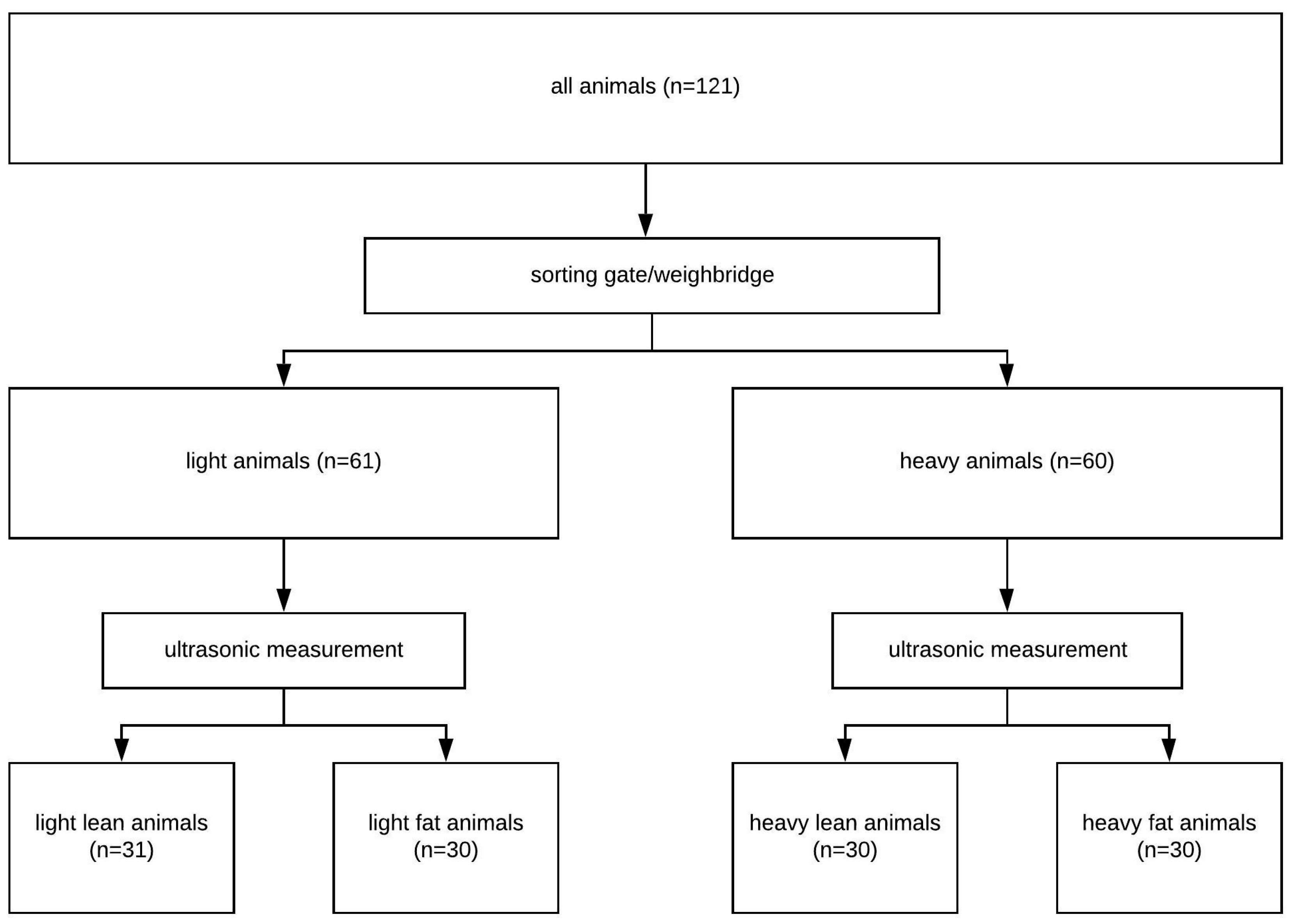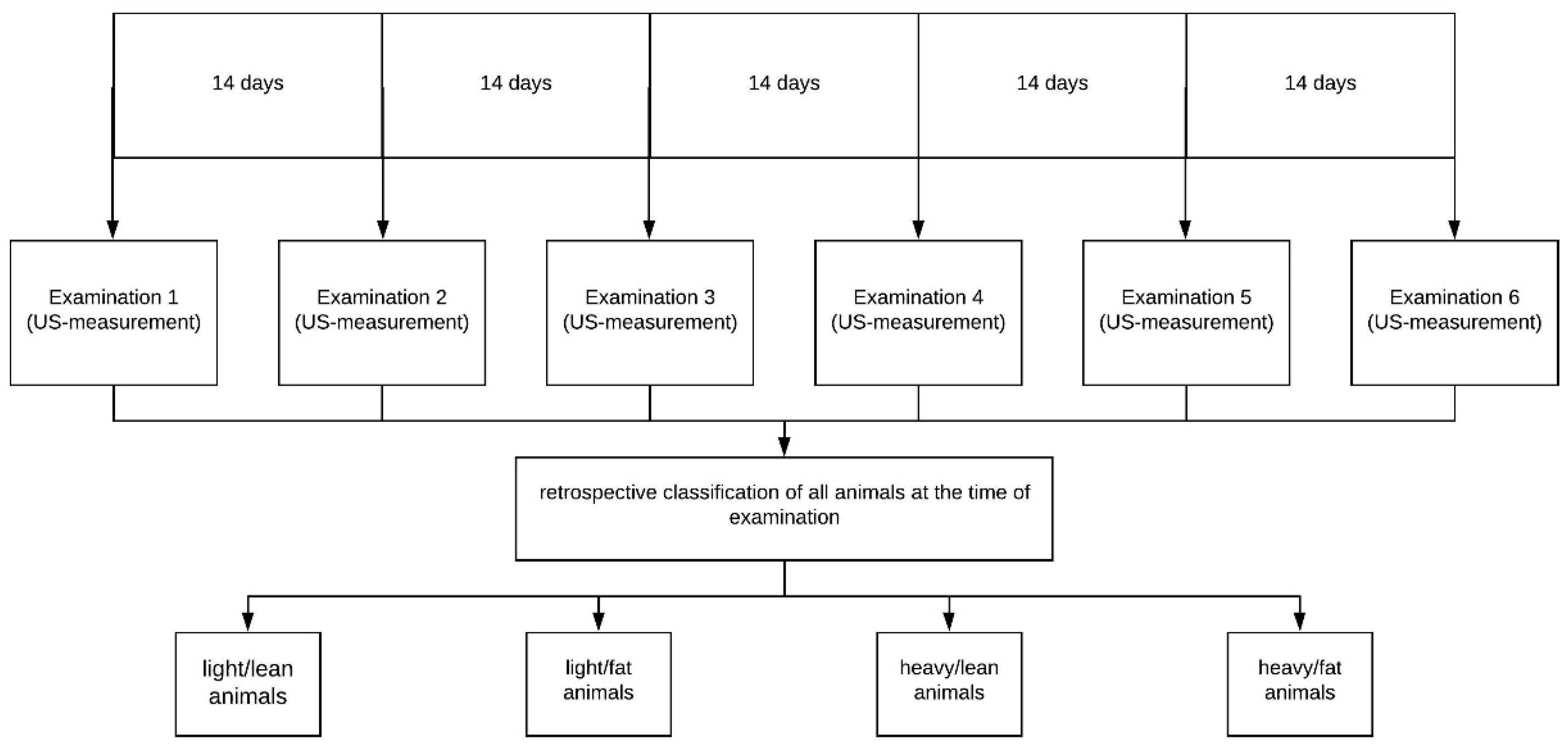Resource-Efficient Classification and Early Predictions of Carcass Composition in Fattening Pigs by Means of Ultrasound Examinations
Abstract
1. Introduction
2. Materials and Methods
2.1. Animals
2.2. Feeding
2.3. Feeding Scheme
2.3.1. Body Mass
2.3.2. Ultrasound Examination
2.3.3. Slaughter Data Analysis
2.3.4. Grouping
2.4. Statistical Analysis
3. Results
4. Discussion
4.1. Heterogeneity of Animals and a Possibility for Resource-Efficient Classification
4.2. Finding the Optimal Time for Grading the Fattening Pigs
4.3. Relationship between Ultrasound Examinations and Slaughter Data
5. Conclusions
Supplementary Materials
Author Contributions
Funding
Acknowledgments
Conflicts of Interest
References
- Font-I-Furnols, M.; Tous, N.; Esteve-Garcia, E.; Gispert, M. Do all the consumers accept marbling in the same way? The relationship between eating and visual acceptability of pork with different intramuscular fat content. Meat Sci. 2012, 91, 448–453. [Google Scholar] [CrossRef] [PubMed]
- Peter, F. Untersuchung zu Zusammenhängen zwischen den Ergebnissen der Eigenleistungsprüfung und dem Erstbelegungsalter von Jungsauen und deren späteren Fruchtbarkeitsleistungen. Neubrandenburg, Hochschule Neubrandenburg, Masterarbeit. Züchtungsk 2011, 83, 182–190. [Google Scholar]
- Hesse, A. Entwicklung Einer Automatischen Konditionsfütterung für Sauen Unter Besonderer Berücksichtigung der Tierleistung; Bundesanstalt für Landwirtschaft (FAL) Landbauforschung: Völkenrode, Germany, 2003; p. 253. [Google Scholar]
- Eckert, S.; Müller, U.; Gschwender, F.; Bergfeld, U.; Schöberlein, L. Drei Vaterrassen im Test: Wer hat die Nase vorn? SUS 2001, 49, 32–35. [Google Scholar]
- Beuck, J. Mit AutoFOM in Ein Neues Zeitalter. eingesehen am 05.03.2016. Available online: http://westfleisch.de/fileadmin/Bilder/03_Landwirtschaft/03.04_Info_Landwirte/03.04.10_2000/03.04.10.00_AutoFOM_11_12_2000.pdf (accessed on 10 November 2019).
- Verordnung über gesetzliche Handelsklassen für Schweineschlachtkörper (Schweineschlachtkörper-Handelsklassenverordnung) in der Fassung der Bekanntmachung vom August 1990(BGBl. I S. 1809), die zuletzt durch Artikel 2 der Verordnung vom Januar 2019 (BGBl. I S. 2) geändert worden ist. Available online: https://www.gesetze-im-internet.de/hdlklschwv_1986/BJNR126240986.html (accessed on 17 January 2020).
- Gilbert, H.; Billon, Y.; Brossard, L.; Faure, J.; Gatellier, P.; Gondret, F.; Labussière, E.; Lebret, B.; Lefaucheur, L.; Le Floch, N.; et al. Review: Divergent selection for residual feed intake in the growing pig. Animals 2017, 11, 1427–1439. [Google Scholar] [CrossRef] [PubMed]
- Schinckel, A.P.; Einstein, M.E. Concepts of pig growth and composition. In Purdue Swine Day; Purdue University: Purdue, IN, USA, 1995. [Google Scholar]
- Hollmichel, K.; Quanz, G. Bedarfsgerechte Proteinversorgung von Schweinen. LLH-Fachinformation Tierproduktion. Available online: http://www.proteinmarkt.de/aktuelle-meldungen/artikel/news/bedarfsgerechte-proteinversorgung/ (accessed on 17 January 2020).
- Kirchgeßner, M. Tierernährung. In Leitfaden für Studium, Beratung und Praxis; Aktualisierte Aufl., DLG-Verl: Frankfurt am Main, Germany, 2014; Volume 14, pp. 305–319. [Google Scholar]
- Bauer, A.; Judas, M. Schlachtkörperqualität von Mastebern in Vergleich zu Sauen und Börgen. Züchtungskunde 2014, 86, 374–389. [Google Scholar]
- Sommer, W. Neue Fütterungsempfehlungen für die Schweinemast. Landwirtschaftskammer Nordrhein-Westfalen. Available online: https://www.landwirtschaftskammer.de/landwirtschaft/tierproduktion/schweinehaltung/fuetterung/empfehlungen-schweinemast.htm (accessed on 17 January 2020).
- Jeroch, H.; Drochner, W.; Ortwin, S. Ernährung Landwirtschaftlicher Nutztiere; Ernährungsphysiologie, Futtermittelkunde, Fütterung; UTB: Stuttgart, Germany, 1999. [Google Scholar]
- Aarnink, A.J.A. Ammonia Emissions from Houses for Growing Pigs as Affected by Pen Design, Indoor Climate and Behaviour. Ph.D. Thesis, University of Wageningen, Wageningen, The Netherlands, 1997. [Google Scholar]
- Lenis, N.P.; Jongbloed, A.W. New Technologies in Low Pollution Swine Diets: Diet Manipulation and Use of Synthetic Amino Acids, Phytase and Phase Feeding for Reduction of Nitrogen and Phosphorus Excretion and Ammonia Emission-Review. Asian-Australasian J. Anim. Sci. 1999, 12, 305–327. [Google Scholar] [CrossRef]
- Lengling, A.; Reckels, B.; Schwennen, C.; Hoelscher, R.; Waldmann, K.-H.; Visscher, C.; Büscher, W. Validation of a New Resource-Efficient Feeding System for Fattening Pigs Using Increased Crude Fiber Concentrations in Diets: Feed Intake and Ammonia Emissions. Animals 2020, 10, 497. [Google Scholar] [CrossRef]
- Susenbeth, A. Factors affecting lysine utilization in growing pigs: An analysis of literature data. Livest. Prod. Sci. 1995, 43, 193–204. [Google Scholar] [CrossRef]
- Schön, A.U.A. Untersuchung zum Muskel- und Fettgewebeansatz Wachsender Schweine. Landwirtschaftskammer Niedersachsen. Available online: http://www.lwk-niedersachsen.de/index.cfm/portal/1/nav/1093/article/17105.html (accessed on 11 February 2020).
- Brade, W.; Flachowsky, G. Schweinezucht und Schweinefleischerzeugung-Empfehlung für die Praxis; Ernährung und Fütterung der Schweine, Sonderheft 2296; Landbauforschung Völkenrode—FAL Agricultural Research; Bundesforschungsanstalt für Landwirtschaft (FAL): Braunschweig, Germany, 2006; pp. 123–155. [Google Scholar]
- Kamphues, J.; Wolf, P.; Coenen, M.; Eder, K.; Iben, C.; Kienzle, E.; Liesegang, A.; Männer, K.; Zebeli, Q.; Zentek, J. Supplemente zur Tierernährung Für Studium und Praxis, 12th überarbeitete Aufl ed; M. & H. Schaper: Hannover, Germany, 2014; Volume 12, pp. 366–374. [Google Scholar]
- Hohmeier, S. Use and Nutritive Value of Whole- Plant Corn Silage as Part of a Ration as Well as Sole Ingredient in Fattening Pigs. Ph.D. Thesis, Tierärztliche Hochschule, Hannover, Germany, 2015. [Google Scholar]
- Meunier-Salaün, M.; Edwards, S.; Robert, S. Effect of dietary fibre on the behaviour and health of the restricted fed sow. Anim. Feed. Sci. Technol. 2001, 90, 53–69. [Google Scholar] [CrossRef]
- D’Eath, R.B.; Tolkamp, B.J.; Kyriazakis, I.; Lawrence, A. ‘Freedom from hunger’ and preventing obesity: The animal welfare implications of reducing food quantity or quality. Anim. Behav. 2009, 77, 275–288. [Google Scholar] [CrossRef]
- Petherick, J.; Blackshaw, J. A review of the factors influencing the aggressive and agonistic behaviour of the domestic pig. Aust. J. Exp. Agric. 1987, 27, 605–611. [Google Scholar] [CrossRef]
- Cielejewski, H.; Tholen, E.; Geerdes, K.; Leuschner, P. Untersuchungen über die Eignung des Videobildsystems opti-SORT (Firma Hoelscher + Leuschner) zur Bestimmung des Gewichts und der Beurteilung der AutoFOM-Schlachtkörperqualität von Schweinen in der Endmast. In Proceedings of the Tagung Bau, Technik und Umwelt in der Landwirtschaftlichen Nutztierhaltung 2005, Braunschweig, Germany, 1–3 März 2005; Kuratorium für Technik und Bauwesen in der Landwirtschaft e. V., Ed.; Landwirtschaftsverl: Münster-Hiltrup, Germany, 2005. [Google Scholar]
- Müller, S.; Polten, S. Vergleichsuntersuchungen zur Ultraschall-Speckdickenmessung beim Schwein im Rahmen der Eigenleistungsprüfung. Arch. Anim. Breed. 2004, 47, 249–263. [Google Scholar] [CrossRef]
- Höreth, R. Praxis-Informationen. Mitt. Fleischforsch. Kulmb. 2013, 52, 175–178. Available online: https://www.openagrar.de/receive/openagrar_mods_00000548 (accessed on 12 May 2020).
- Brøndum, J.; Egebo, M.; Agerskov, C.; Busk, H. On-line pork carcass grading with the Autofom ultrasound system. J. Anim. Sci. 1998, 76, 1859–1868. [Google Scholar] [CrossRef] [PubMed]
- Branscheid, W.; Judas, M.; Höreth, R. Zur Klassifizierung von Schweinehälften: Neue Schätzformel und neue Geräte. Mitt. Fleischforsch. Kulmb. 2011, 50, 9–28. [Google Scholar]
- Canh, T.; Aarnink, A.; Schutte, J.; Sutton, A.; Langhout, D.; Verstegen, M. Dietary protein affects nitrogen excretion and ammonia emission from slurry of growing–finishing pigs. Livest. Prod. Sci. 1998, 56, 181–191. [Google Scholar] [CrossRef]
- Giles, L.R.; Eamens, G.J.; Arthur, P.F.; Barchia, I.M.; James, K.J.; Taylor, R.D. Differential growth and development of pigs as assessed by X-ray computed tomography1. J. Anim. Sci. 2009, 87, 1648–1658. [Google Scholar] [CrossRef] [PubMed][Green Version]
- Overholt, M.F.; Arkfeld, E.K.; Mohrhauser, D.A.; King, D.A.; Wheeler, T.L.; Dilger, A.C.; Shackelford, S.; Boler, D. Comparison of variability in pork carcass composition and quality between barrows and gilts1. J. Anim. Sci. 2016, 94, 4415–4426. [Google Scholar] [CrossRef]
- Moeller, S.J.; Christian, L.L.; Goodwin, R.N. Development of adjustment factors for backfat and loin muscle area from serial real-time ultrasonic measurements on purebred lines of swine. J. Anim. Sci. 1998, 76, 2008–2016. [Google Scholar] [CrossRef]




| Diet 50 kg | Diet 60 kg | Diet 70 kg | Diet 50 kg | Diet 60 kg | Diet 70 kg | ||
|---|---|---|---|---|---|---|---|
| Light | Light | Light | Heavy | Heavy | Heavy | ||
| ME | MJ kg DM | 15.11 | 15.10 | 15.11 | 15.11 | 15.10 | 15.00 |
| Ash | g/kg DM | 44.80 | 43.00 | 43.00 | 44.80 | 43.10 | 43.20 |
| Crude Protein | g/kg DM | 172.00 | 167.00 | 167.00 | 172.00 | 167.00 | 167.00 |
| Crude Fat | g/kg DM | 42.40 | 42.30 | 42.30 | 42.40 | 41.30 | 40.40 |
| Starch | g/kg DM | 471.00 | 486.00 | 486.00 | 471.00 | 489.00 | 492.00 |
| Crude Fiber | g/kg DM | 46.70 | 45.10 | 45.10 | 46.70 | 46.40 | 47.70 |
| Lysin | g/kg DM | 12.10 | 11.50 | 11.50 | 12.10 | 11.10 | 10.80 |
| Item | Group | Examination 1 | Examination 2 | Examination 3 | Examination 4 | Examination 5 |
|---|---|---|---|---|---|---|
| Body | L | 42.90 B ± 3.54 | 56.68 B ± 4.68 | 69.37 B ± 5.50 | 81.80 B ± 6.97 | 91.82 B ± 6.28 |
| weight (in kg) | H | 52.90 A ± 4.20 | 65.71 A ± 6.83 | 78.49 A ± 7.46 | 89.53 A ± 9.58 | 99.50 A ± 10.21 |
| Backfat/muscle | L | 0.11 A ± 0.02 | 0.15 A ± 0.02 | 0.17 A ± 0.03 | 0.18 A ± 0.03 | 0.19 A ± 0.03 |
| ratio | H | 0.11 A ± 0.02 | 0.14 A ± 0.02 | 0.16 A ± 0.02 | 0.18 A ± 0.03 | 0.18 A ± 0.03 |
| Body weight (in kg) | LF | 43.50 B ± 3.08 | 57.22 B ± 5.24 | 70.08 B ± 6.01 | 82.81 B ± 7.51 | 92.78 B ± 6.69 |
| LL | 42.30 B ± 3.88 | 56.16 B ± 4.10 | 68.69 B ± 4.96 | 80.77 B ± 7.52 | 90.90 B ± 5.81 | |
| HF | 52.26 A ± 3.95 | 65.59 A ± 5.52 | 78.07 A ± 6.01 | 88.05 A ± 9.30 | 98.71 A ± 9.93 | |
| HL | 53.54 A ± 4.41 | 65.83 A ± 8.04 | 78.93 A ± 8.82 | 91.07 A ± 9.81 | 100.27 A ± 10.61 | |
| Backfat/muscle ratio | LF | 0.13 A ± 0.01 | 0.16 A ± 0.02 | 0.18 A ± 0.03 | 0.18 A ± 0.03 | 0.20 A ± 0.04 |
| LL | 0.11 B ± 0.01 | 0.13 B ± 0.02 | 0.16 BC ± 0.03 | 0.17 A ± 0.03 | 0.17 B ± 0.03 | |
| HF | 0.13 A ± 0.02 | 0.15 A ± 0.02 | 0.17 AB ± 0.03 | 0.18 A ± 0.03 | 0.19 A ± 0.02 | |
| HL | 0.10 B ± 0.01 | 0.14 B ± 0.02 | 0.15 C ± 0.02 | 0.17 A ± 0.03 | 0.17 B ± 0.03 |
| Item | Group | Examination 1 | Examination 2 | Examination 3 | Examination 4 | Examination 5 |
|---|---|---|---|---|---|---|
| Diameter of M. longissimus dorsi (cm) | All | 3.63 ± 0.37 | 4.31± 0.42 | 4.66 ± 0.46 | 5.14 ± 0.41 | 5.51 ± 0.47 |
| Heavy | 3.81 A ± 0.35 | 4.48 A ± 0.42 | 4.88 A ± 0.34 | 5.28 A ± 0.40 | 5.62 A ± 0.47 | |
| Light | 3.46 B ± 0.31 | 4.14 B ± 0.34 | 4.44 B ± 4.47 | 4.99 B ± 0.36 | 5.40 B ± 0.45 | |
| Diameter of M. longissimus dorsi (cm) | LF | 3.29 C ± 0.28 | 4.01 C ± 0.36 | 4.33 B ± 0.44 | 4.87 C ± 0.28 | 5.29 B ± 0.38 |
| LL | 3.62 B ± 0.24 | 4.25 B ± 0.26 | 4.55 B ± 0.47 | 5.12 B ± 0.40 | 5.50 AB ± 0.48 | |
| HF | 3.69 B ± 0.31 | 4.45 AB ± 0.38 | 4.81 A ± 0.39 | 5.16 B ± 0.36 | 5.50 AB ± 0.47 | |
| HL | 3.93 A ± 0.35 | 4.52 A ± 0.46 | 4.96 A ± 0.28 | 5.40 A ± 0.42 | 5.75 A ± 0.45 | |
| Backfat (cm) | All | 0.42 ± 0.07 | 0.62 ± 0.10 | 0.76 ± 0.13 | 0.89 ± 0.15 | 1.02 ± 0.18 |
| Heavy | 0.43 A ± 0.08 | 0.64 A ± 0.10 | 0.78 A ± 0.11 | 0.92 A ± 0.16 | 1.03 A ± 0.16 | |
| Light | 0.41 A ± 0.06 | 0.59 B ± 0.09 | 0.74 A ± 0.13 | 0.87 A ± 0.13 | 1.00 A ± 0.18 | |
| Backfat (cm) | LF | 0.44 A ± 0.06 | 0.62 AB ± 0.11 | 0.78 A ± 0.15 | 0.89 AB ± 0.14 | 1.04 A ± 0.21 |
| LL | 0.38 B ± 0.09 | 0.57 B ± 0.07 | 0.70 B ± 0.11 | 0.84 B ± 0.12 | 0.96 A ± 0.14 | |
| HF | 0.47 A ± 0.09 | 0.67 A ± 0.09 | 0.81 A ± 0.12 | 0.96 A ± 0.17 | 1.07 A ± 0.15 | |
| HL | 0.39 B ± 0.04 | 0.61 AB ± 0.10 | 0.74 AB ± 0.10 | 0.87 AB ± 0.14 | 0.99 A ± 0.16 |
| Item | Group | Examination 1 | Examination 2 | Examination 3 | Examination 4 | Examination 5 |
|---|---|---|---|---|---|---|
| Diameter of M. longissimus dorsi (cm) | All | 3.63 ± 0.37 | 4.31 ± 0.42 | 4.66 ± 0.46 | 5.14 ± 0.41 | 5.51 ± 0.47 |
| Heavy | 3.78 A ± 0.38 | 4.48 A ± 0.43 | 4.89 A ± 0.37 | 5.31 A ± 0.40 | 5.68 A ± 0.43 | |
| Light | 3.47 B ± 0.28 | 4.13 B ± 0.32 | 4.13 B ± 0.44 | 4.98 B ± 0.34 | 5.35 B ± 0.47 | |
| Diameter of M. longissimus dorsi (cm) | LF | 3.45 B ± 0.29 | 3.99 C ± 0.34 | 4.32 C ± 0.42 | 4.91 C ± 0.31 | 5.30 B ± 0.43 |
| LL | 3.50 B ± 0.29 | 4.28 B ± 0.21 | 4.56 BC ± 0.44 | 5.07 BC ± 0.37 | 5.41 AB ± 0.51 | |
| HF | 3.73 A ± 0.37 | 4.34 B ± 0.45 | 4.80 AB ± 0.43 | 5.25 AB ± 0.45 | 5.69 A ± 0.45 | |
| HL | 3.83 A ± 0.39 | 4.62 A ± 0.35 | 4.97 A ± 0.28 | 5.37 A ± 0.34 | 5.67 A ± 0.42 | |
| Backfat (cm) | All | 0.42 ± 0.069 | 0.62 ± 0.10 | 0.76 ± 0.13 | 0.89 ± 0.15 | 1.02 ± 0.18 |
| Heavy | 0.44 A ± 0.06 | 0.66 A ± 0.10 | 0.80 A ± 0.12 | 0.93 A ± 0.16 | 1.05 A ± 0.16 | |
| Light | 0.40 B ± 0.04 | 0.57 B ± 0.07 | 0.72 B ± 0.12 | 0.84 B ± 0.12 | 0.97 B ± 0.17 | |
| Backfat (cm) | LF | 0.42 B ± 0.04 | 0.61 B ± 0.07 | 0.77 B ± 0.12 | 0.89 B ± 0.13 | 1.05 B ± 0.17 |
| LL | 0.37 C ± 0.03 | 0.52 C ± 0.05 | 0.65 C ± 0.08 | 0.80 B ± 0.09 | 0.88 D ± 0.10 | |
| HF | 0.45 A ± 0.07 | 0.71 A ± 0.10 | 0.85 A ± 0.12 | 0.99 A ± 0.13 | 1.14 A ± 0.13 | |
| HL | 0.42 B ± 0.05 | 0.61 B ± 0.07 | 0.74 B ± 0.10 | 0.87 B ± 0.16 | 0.96 C ± 0.14 |
| Item | Group | Examination 1 | Examination 2 | Examination 3 | Examination 4 | Examination 5 |
|---|---|---|---|---|---|---|
| Diameter of M. longissimus dorsi (cm) | All | 3.63 ± 0.37 | 4.31 ± 0.42 | 4.66 ± 0.46 | 5.14 ± 0.41 | 5.51 ± 0.47 |
| Heavy | 3.78 A ± 0.40 | 4.49 A ± 0.40 | 4.85 A ± 0.42 | 5.29 A ± 0.41 | 5.70 A ± 0.41 | |
| Light | 3.46 B ± 0.30 | 4.15 B ± 0.34 | 4.45 B ± 0.42 | 4.97 B ± 0.36 | 5.28 B ± 0.45 | |
| Diameter of M. longissimus dorsi (cm) | LF | 3.35 C ± 0.31 | 4.03 B ± 0.36 | 4.27 C ± 0.47 | 4.83 C ± 0.33 | 5.20 C ± 0.43 |
| LL | 3.58 BC ± 0.25 | 4.27 AB ± 0.27 | 4.65 B ± 0.27 | 5.13 B ± 0.32 | 5.36 BC ± 0.47 | |
| HF | 3.71 AB ± 0.37 | 4.43 A ± 0.38 | 4.69 B ± 0.42 | 5.15 B ± 0.35 | 5.58 AB ± 0.40 | |
| HL | 3.85 A ± 0.42 | 4.56 A ± 0.42 | 5.01 A ±0.35 | 5.43 A ± 0.42 | 5.82 A ± 0.39 | |
| Backfat (cm) | All | 0.42 ± 0.07 | 0.62 ± 0.10 | 0.76 ± 0.13 | 0.89 ± 0.15 | 1.02 ± 0.18 |
| Heavy | 0.45 A ± 0.08 | 0.68 A ± 0.09 | 0.81 A ± 0.12 | 0.94 A ± 0.16 | 1.07 A ± 0.16 | |
| Light | 0.39 B ± 0.04 | 0.56 B ± 0.06 | 0.70 B ± 0.11 | 0.83 B ± 0.11 | 0.96 B ± 0.16 | |
| Backfat (cm) | LF | 0.41 B ± 0.03 | 0.58 BC ± 0.07 | 0.76 B ± 0.11 | 0.87 B ± 0.12 | 1.01 B ± 0.18 |
| LL | 0.37 B ± 0.03 | 0.53 C ± 0.05 | 0.64 C ± 0.05 | 0.78 C ± 0.08 | 0.90 C ± 0.10 | |
| HF | 0.48 A ± 0.09 | 0.72 A ± 0.08 | 0.89 A ± 0.08 | 1.05 A ± 0.11 | 1.12 A ± 0.12 | |
| HL | 0.42 B ± 0.05 | 0.63 B ± 0.08 | 0.72 B ± 0.09 | 0.84 BC ± 0.14 | 0.97 BC ± 0.13 |
| Item | Group | Examination 1 * | Examination 2 | Examination 3 | Examination 4 | Examination 5 * | |
|---|---|---|---|---|---|---|---|
| Body mass (kg) correlated to muscle diameter (cm) | All | r | 0.6184 | 0.54373 | 0.5377 | 0.53526 | 0.51723 |
| (n = 121) | p | <0.0001 | <0.0001 | <0.0001 | <0.0001 | <0.0001 | |
| LF | r | 0.21092 | 0.47796 | 0.1857 | 0.32893 | 0.46296 | |
| (n = 30) | p | 0.2632 | 0.0117 | 0.3638 | 0.0874 | 0.0131 | |
| LL | r | 0.57438 | 0.48569 | 0.36308 | 0.31899 | 0.42297 | |
| (n = 31) | p | 0.0007 | 0.0088 | 0.0627 | 0.1048 | 0.0199 | |
| HF | r | 0.56916 | 0.40454 | 0.35525 | 0.48281 | 0.3191 | |
| (n = 30) | p | 0.001 | 0.0364 | 0.0636 | 0.0093 | 0.0979 | |
| HL | r | 0.64511 | 0.40045 | 0.73677 | 0.65097 | 0.74759 | |
| (n = 30) | p | 0.0001 | 0.0347 | <0.0001 | 0.0002 | <0.0001 |
| Item | Group | Examination 1 | Examination 2 | Examination 3 | Examination 4 | Examination 5 | |
|---|---|---|---|---|---|---|---|
| Amount of fat/amount of meat correlated to backfat/muscle ratio | All | r | 0.38988 | 0.48620 | 0.57047 | 0.64251 | 0.66378 |
| (n = 121) | p | <0.0001 | <0.0001 | <0.0001 | <0.0001 | <0.0001 | |
| LF | r | 0.36914 | 0.51464 | 0.42413 | 0.72587 | 0.69135 | |
| (n = 30) | p | 0.0447 | 0.0051 | 0.0275 | <0.0001 | <0.0001 | |
| LL | r | 0.15725 | 0.45254 | 0.50255 | 0.29036 | 0.60602 | |
| (n = 31) | p | 0.3982 | 0.0156 | 0.0064 | 0.1339 | 0.0004 | |
| HF | r | 0.22987 | 0.27088 | 0.63312 | 0.77736 | 0.61204 | |
| (n = 30) | p | 0.2217 | 0.1717 | 0.0003 | <0.0001 | 0.0005 | |
| HL | r | 0.18397 | 0.24769 | 0.52356 | 0.71370 | 0.70164 | |
| (n = 30) | P | 0.3305 | 0.2038 | 0.0051 | <0.0001 | <0.0001 |
| Item | Group | Examination 1 | Examination 2 | Examination 3 | Examination 4 | Examination 5 | |
|---|---|---|---|---|---|---|---|
| all | r | −0.28164 | −0.44417 | −0.51052 | −0.59201 | −0.60657 | |
| Index points per kg to backfat/muscle ratio | (n = 121) | p | 0.0018 | <0.0001 | <0.0001 | <0.0001 | <0.0001 |
| SF | r | −0.35456 | −0.47912 | −0.43638 | −0.70450 | −0.65226 | |
| (n = 30) | p | 0.0545 | 0.0099 | 0.0229 | <0.0001 | 0.0001 | |
| SL | r | −0.12204 | −0.53207 | −0.50105 | −0.17746 | −0.53933 | |
| (n = 31) | p | 0.5131 | 0.0036 | 0.0066 | 0.3663 | 0.0021 | |
| HF | r | −0.12797 | −0.23416 | −0.59018 | −0.64012 | −0.57583 | |
| (n = 30) | p | 0.5004 | 0.2398 | 0.0009 | 0.0002 | 0.0013 | |
| HL | r | −0.07190 | −0.26046 | −0.42133 | −0.71739 | −0.63235 | |
| (n = 30) | p | 0.7058 | 0.1807 | 0.0286 | <0.0001 | 0.0002 |
© 2020 by the authors. Licensee MDPI, Basel, Switzerland. This article is an open access article distributed under the terms and conditions of the Creative Commons Attribution (CC BY) license (http://creativecommons.org/licenses/by/4.0/).
Share and Cite
Reckels, B.; Hölscher, R.; Schwennen, C.; Lengling, A.; Stegemann, U.; Waldmann, K.-H.; Visscher, C. Resource-Efficient Classification and Early Predictions of Carcass Composition in Fattening Pigs by Means of Ultrasound Examinations. Agriculture 2020, 10, 222. https://doi.org/10.3390/agriculture10060222
Reckels B, Hölscher R, Schwennen C, Lengling A, Stegemann U, Waldmann K-H, Visscher C. Resource-Efficient Classification and Early Predictions of Carcass Composition in Fattening Pigs by Means of Ultrasound Examinations. Agriculture. 2020; 10(6):222. https://doi.org/10.3390/agriculture10060222
Chicago/Turabian StyleReckels, Bernd, Richard Hölscher, Cornelia Schwennen, Alexandra Lengling, Ute Stegemann, Karl-Heinz Waldmann, and Christian Visscher. 2020. "Resource-Efficient Classification and Early Predictions of Carcass Composition in Fattening Pigs by Means of Ultrasound Examinations" Agriculture 10, no. 6: 222. https://doi.org/10.3390/agriculture10060222
APA StyleReckels, B., Hölscher, R., Schwennen, C., Lengling, A., Stegemann, U., Waldmann, K.-H., & Visscher, C. (2020). Resource-Efficient Classification and Early Predictions of Carcass Composition in Fattening Pigs by Means of Ultrasound Examinations. Agriculture, 10(6), 222. https://doi.org/10.3390/agriculture10060222





